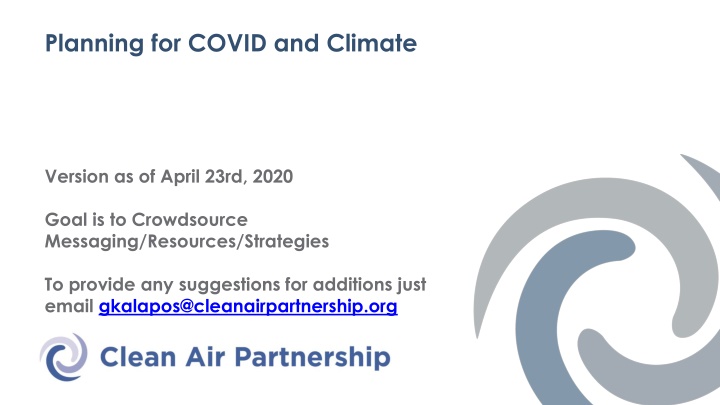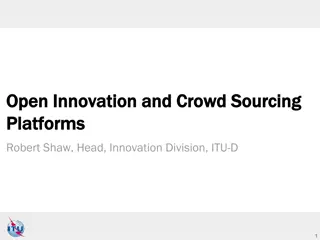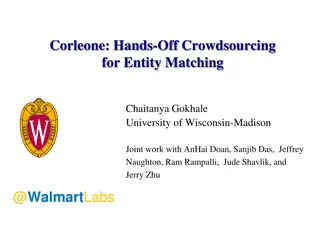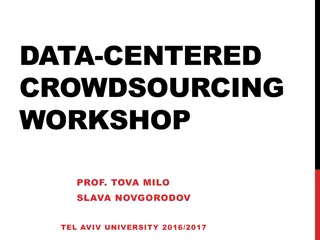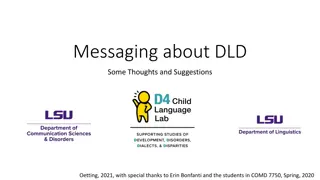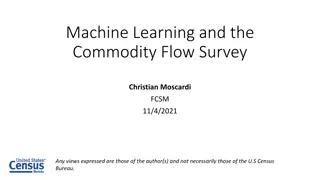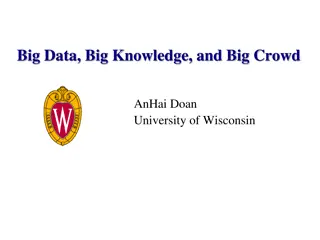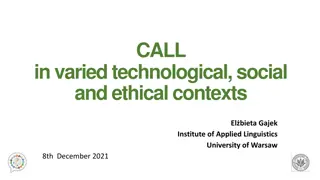Crowdsourcing Messaging for COVID and Climate Connection
Align COVID response with climate change goals to protect public health and ensure a sustainable future. Collective action crucial for success. Lessons learned highlight societal capacity for change.
Download Presentation

Please find below an Image/Link to download the presentation.
The content on the website is provided AS IS for your information and personal use only. It may not be sold, licensed, or shared on other websites without obtaining consent from the author.If you encounter any issues during the download, it is possible that the publisher has removed the file from their server.
You are allowed to download the files provided on this website for personal or commercial use, subject to the condition that they are used lawfully. All files are the property of their respective owners.
The content on the website is provided AS IS for your information and personal use only. It may not be sold, licensed, or shared on other websites without obtaining consent from the author.
E N D
Presentation Transcript
Planning for COVID and Climate Version as of April 23rd, 2020 Goal is to Crowdsource Messaging/Resources/Strategies To provide any suggestions for additions just email gkalapos@cleanairpartnership.org
Planning for COVID and Climate Goals 1. Discussion/Input RE: COVID/Climate Connections messaging. Hoping to get your input on the messaging developed thus far. Sustainability/Climate Lens applied to municipal COVID Response and Recovery Plans. Ensuring a sustainability lead and lens application within municipal COVID teams. CAP would facilitate a crowd sourcing support across municipalities to enable the application of the lens, resources, perspectives, action items to support the application of a Sustainability/Climate Lens application. Municipal advocacy re advancing a Climate friendly COVID Economic Recovery Strategy. Gathering collective input on what municipalities see as priorities. Other needed supports/priorities as you see them, just let us know. 2. 3. 4. 5.
Aligning COVID response to Climate Change COVID is an immediate threat. Has health implications for about 15% of the population. Actions undertaken by all individuals will have an impact on determining the death rate of those 15% of people that experience serious health impacts from COVID. To protect those people all need to play a role in influencing how much of the population is exposed to that risk by how much they play a role in spreading COVID. COVID is our Sprint. Climate Change is our longer term threat. It is our Marathon. How well we enable our response to this COVID sprint to be aligned with our climate, low carbon economy, and equity goals will impact how well prepared we are to run our climate marathon.
COVID and Climate Connection COVID is a climate practice run. We have an immediate threat to our survival. Varied death rate of COVID (overwhelming the health care system or versus flu) is an analogy for the difference between 1. 5 and 2 or 3 or 4 degree increase in average temperatures. Small differences make a huge difference when large populations are impacted. Equity has a huge impact on exposure, impacts, outcomes. For solutions to work .. Each one of us can and needs to practice behaviours that mitigate our risks and others risks The choices each one of us makes will determine the heath threats we all will face We need science and results to understand our threats, and to know what we can do about it Individual actions matter, but individuals cannot do it alone Business actions matter, but business cannot do alone We need governments to set the collective structures in place that allow, enable, and ensure the actions undertaken by individuals, business and all sectors of society put what science says works to reduce health impacts into action. It wont work without collective and aligned action.
COVID and Climate Connection (cont..) Additional Lessons learned also include That despite what has been the prevailing wisdom thus far society can (and did) make massive changes to its functioning when there is aligned efforts taken by all (governments, businesses, individual's, etc.) Increased appreciation for scientific expertise when addressing systemic issues. This may also lead to a greater recognition/appetite for the preventative and coordinating role of government in tackling systemic climate risks. Governments as the payor, lender and insurer of last resort for many may help to build increased recognition of their role and the value proposition for ensuring resilience to climate change extreme weather events and other societal disrupters. Increased recognition within society of the opportunity and the need to build back better after the COVID crisis. Climate change mitigation and resilience actions can drive significant near-term job creation while increasing economic and environmental resiliency. With very low interest rates make this a great time to make such investments.
COVID and Climate Connection Infectious outbreaks could become more common as climate change forces animals and humans into closer proximity. Permafrost melting, pathogen release Bob McDonald, COVID 19 vulnerability, COVID- and climate and more Bill McKibben, What can coronavirus efforts teach us in the fight against climate change?
Air Pollution Air pollution heath impacts increase our heath risks from COVID https://www.theguardian.com/environment/2020/apr/07/air-pollution- linked-to-far-higher-COVID-19-death-rates-study-finds Reducing people s exposure to air pollution in the short term during COVID crisis transportation emissions reductions achieved How to ensure that as things return to pre-COVID levels of service but COVID still poses of threat of recurrence? Reducing people s exposure to air pollution in the longer term for longer term public health benefits. Air pollution exposure kills. Nearly 800,000 people die prematurely each year in Europe because of dirty air, and each life is cut short by an average of more than two years. https://academic.oup.com/eurheartj/article/40/20/1590/5372326
Inequality COVID is exposing stark socio-economic inequalities Will likely exacerbate them Financial risk re loss of employment Personal distancing limitations Increased exposure to COVID in employment Climate change will have differential impacts on geographies and populations and also exposes stark socio-economic inequalities US News (April 1, 2020) Why We Can't Ignore the Link Between COVID-19, Climate Change and Inequity
Nurturing caring values, communicating in a pandemic: While not undermining environmental protection now and in the future: Louise Comeau Conservation Council of New Brunswick People are concerned about safety, security and well being. Think of communications through that lens There is the opportunity to situate environmental protection as a social justice issue and to our capacity to take care of each other. This is a time for care and inter-connectedness framing Opportunities for change are emerging and there is greater appreciation for the important role data, expertise and governments play in protecting Canadians. There is growing awareness of inequality and increased appreciation for the role lower paid workers play in sustaining food and health systems that we all rely on. Economic disruption can create opportunities for socializing systems change and transformative climate action. Social change or new social norms could emerge ex. more acceptance of work/life balance, teleworking, consumption.
Nurturing caring values, communicating in a pandemic: While not undermining environmental protection now and in the future: Louise Comeau Conservation Council of New Brunswick (cont ) Communications Tips Don t only talk about economic stimulus, talk about just recovery, rebuilding, renewing, reimagining, economic and ecological resilience, community and personal preparedness and security. Try not to use the war narrative. This is a love story, not a war one. This is about humanity coming together to protect each other, putting public health and lives as a priority, it shows our inter-connectedness, dependence on each other, how humans are willing to support each other and make sacrifices for each other s sake. It shows our respect and appreciation for our shared humanity.
Summary of COVID/Climate Connections We can tackle monumental challenges: A key lesson from COVID is we can muster society, the policies, and the financial resources to quickly address problems of significant importance. Timing Matters: With COVID-19, quick action by health and governmental officials on COVID has made a huge difference. The longer we wait to mitigate and prepare for the climate emergency, the more it will cost us both in lives and livelihoods. Crises highlight injustices in society: COVID-19 is shining a light on the health, economic, societal, and racial inequities embedded in our society. Preparation Matters: Countries like South Korea that were prepared with good public health systems and pandemic-trained professionals ready with testing, protection, and treatment equipment and supplies, have had much lower COVID-19 incidence and much quicker recovery than we ve had. We must prepare for climate change with similar mastery. Science and Facts Matter: Trust in experts and science has been critical for the successes in COVID-19 response and public welfare. We need our society and leaders to understand the importance of science, facts and climate realities; the existential threats and the opportunities. Leadership Matters: We need our leaders to step up and champion the information, plans, and resources to effectively address climate change. Individual actions matter, but can t succeed without systems put in place to ensure all individuals join the effort. Transparency and Honesty Matter Reference: EcoAmerica (April 10, 2020) Climate Leadership Amidst COVID 19
COVID Economic Recovery and Climate Action
How We Advance our COVID Recovery will Influence us for the Next Generation How we choose to help our communities and our economy recover from COVID will influence the direction we move in for the next 10 15 years. Go through each of our climate actions and identify the economic recovery elements of those actions Employment opportunities What can that be done in a qualitative way What can that be done in a quantitative way Who would we need to work with to help enable us to do that? What new challenges and opportunities will our post COVID emergency bring upon us. We will be better able to address challenges and advance opportunities by working together and supporting each other s efforts.
Green Space Definition of Green Space: parks, sports fields, woods, grassland and meadows, wetlands and other ecosystems. Different types of green spaces may require different approaches depending on how much an issue physical distancing requirements would be to practice and enforce. Balance between providing access to space to exercise and for mental health. Ensuring that physical distancing is being practiced. Trying to better understand the leading practice re: How to ensure/enforce? People power needed to make sure it is not having the unintended consequence of too many people using at once. Government can t do this on its own. Question to ponder .Longer term appreciation of the value of green space. How to advance that to increase green space in communities over the longer term?
Green Space How municipalities are dealing with Green Spaces during COVID emergency (different strategies and pros and cons) Closing off access completely Not well received, has public health implications re space for exercise. Has significant equity implications in that some residents may have outdoor space (such as those with backyards) but many residents without private outdoor space rely on public green spaces. Closing off parking (thereby reducing access to green spaces to help with physical distancing but still allows for use by local communities). Can have equity implications as green space is not equally accessible across our communities. Can foster research and consideration within municipalities re the equitable access to green space across the community. Different strategies needed for playgrounds or other riskier touch amenities. However there are different risks between playground and green spaces. Shouldn t there be a different strategy re playgrounds, sport fields, and green spaces? Allowing access with physical distancing requirements still in place. Parking lots pose a risk re physical distancing. Signage and consideration is key to getting residents to respect and practice physical distancing. Physical distancing pathway allocation space. May need to require direction instructions in order to allow space for passing while physical distancing. Adding in additional pathways (can be temporary or made permanent) How to enforce: getting residents to report when there are issues; using drones; signage that the green space will only be accessible if physical distancing requirements are followed; allowing access based on license plate; may need to close off access if its not being practiced; Having to close down access to green space if physical distancing isn't being followed. Good education and promotion opportunity to encourage appropriate behavior.
Green Space, Climate & Health Connections Space for physical exercise, obesity intervention and associated public health benefits such as mental health Air quality improvements Urban heat island reductions and heat stress reduction Precipitation/stormwater and flood management Carbon sink Social cohesion/social capital value (always gets underestimated) How can this present an opportunity to make sure equity to green space benefits are provided to all communities with special emphasis for those least served thus far.
Green Space How the COVID experience may be able to build more public/political support for the value of green space? Underutilized space and Green Space conversions? Can this help with supports for Green Streets? Possibility of increased resident support/advocacy for more green space across the community. Or more diversity in allocation to non sport-fields land uses within green spaces? For our green spaces to serve a wider variety of uses across our communities. Either in the short-term while sport fields may be out of use or over the longer term re increasing more diverse uses through Parks Master Planning process. Hoped for outcome: can COVID experience build a new approach to city planning that brings open spaces, watersheds, forests and parks into the heart of how we think about and plan our communities? Brainstorming messaging & resources so that all can be equipped to engage in these conversations in their municipality and communities.
Green Space Action Items Has your municipality done any analysis of the equitable access to green space across the community? If not yet, that would be important to undertake. Is equitable access to Green Space taken into consideration in identifying priority neighbourhoods? What methodology/mapping tools may be able to help municipalities undertake the above work? Which municipalities have already undertaken this work and can share their experiences? If your municipality has advanced such work please let Gaby know at: gkalapos@cleanairpartnership.org
Green Space Learnings Windsor did explore equity re access to green space as part of their Parks Master Plan Oshawa as part of the MNAI exploring how green space access can be brought into the priority neighbourhoods identification methodology. Peel Region Priority Planning Mapping Tool may provide insights into methodology.
Community Gardening and Urban Agricultures Plans Work taking place to classify community gardens as an essential service. Sustain Ontario is working with the Province on that and has highlighted approaches across Canada. How can COVID lend support to food security actions?
Community Gardening Efforts and Considerations Victoria. BC has assigned Parks staff to start growing vegetable seedlings for residents. North Carolina: COVID-19 FAQ for Community Gardens Strategies to enable physical distancing at community gardens (if not enough space may need to time share access (possibly via numbering plots and allocating days/times based on even and odd numbers to provide more buffer space for physical distancing). Brampton, Ontario: Community Gardening program is closed however they have set up a Backyard Garden Program Some implementation issues to consider should include: How residents sign up, limits on numbers? What residents is serves? (i.e. is it geared towards those who food security is likely to be a significant concern? How equitably does it serve residents? i.e what about resident s without access to a back yard? How to ensure food grown makes it to a food bank or to those in need? How would the program handle delivery and supply issues? Kingston, ON discussed community garden access at their April 22nd, 2020 Council meeting. Action Item: CAP will follow up.
What can be done to make public transportation more safe? COVID presents a significant risk to transit ridership over the shorter term Shorter term changes can lead to longer term modal shift Physical distancing; contact tracing; notifications of exposure How to respond to these challenges? Active transportation and micro-mobility for shorter trips What are the leading practices from other jurisdictions to reduce/manage risk?
Active Transportation and Micro-Mobility Milan announces ambitious scheme to reduce car use after lockdown Bogota, Weekday Ciclovia How can we provide more physical distancing to better enable people to use active transportation while maintaining physical distancing recommendations? How can micro-mobility help? What unintended consequences might there be that we should aim to address?
Telecommuting Policies over the Longer Term Experience during COVID with management via results based approach rather than baby sitting approach Ability to advance telecommuting options post COVID What are the opportunities and issues that can have an impact over the longer term? What can we do about them Reducing barriers and instituting telecommuting policies and procedures over the longer term What would that look like?
COVID/Climate Mitigation Lens Buildings Building retrofits present a huge economic recovery opportunity How would we quantify that? What would be the value of quantifying that? How can be best communicate the synergies between building retrofits and economic stimulus? Who is working on that? Ex. Efficiency Canada How can we work with them?
Food Security Urban Agriculture Plans How do they advance resilience to COVID food insecurity risk. How would we put the actions in a place that takes COVID into consideration. How to manage community gardens to enable their use while ensuring COVID measures are adhered to.
Climate Adaptation Actions Where is there potential for alignment between plan actions and our COVID response over the short/medium/long term?
Waste Management How to ensure that COVID needs and fears do not negate progress made on zero waste efforts? What can be done in the shorter term? Over the longer term?
Economic Development Plans How do we ensure that climate actions are incorporated into COVID economic recovery response? Who should we work with? Climate Action Network facilitating civic society organizations and messages Climate Caucus exploring this from a municipal perspective Specific Ontario message?
Identifying and Addressing COVID Response Actions that Undermine Climate Progress Fossil fuel company bailouts advocacy position? Civic society advancing this message Would be great to get municipalities also communicating the risks and limitations of additional high carbon sector bail outs/subsidies Getting conversation in front of councils. Communications from Clean Air Council Communications directly from Municipal Councils
Possible Processes for Advancing this Work Crowd sourcing resources/actions/thoughts Identifying real world examples of COVID/Climate approaches Working Group to advance exploration and advancement of this overall work. Discussions would be topic focused so that people can self select the topic they would like to contribute to Discussions would be accelerated in order to try and bring thinking into municipal recovery plans Other suggestions for processes and efforts that can support this effort?
Actual Examples of Climate Actions that Help with our Immediate COVID Response
Actual Examples to Show Opportunities Active Transportation, Public Space New Zealand First Country To Fund Pop-Up Bike Lanes, Widened Sidewalks During Lockdown City of London, Ontario: Bike Giveaway City of London, ON closes streets/bridges to cars to give cyclists & pedestrians more space Bike Share Supports from NACTO City Transportation Action Updates (go to chart) Calgary to reduce lanes on some roads to help walkers, cyclists keep their distance during COVID Edmonton making more room for pedestrians on two roads, eliminating beg buttons at 56 intersections Mapping How Cities Are Reclaiming Street Space Bogota added an additional 76 Kms of bike routes during weekdays. Montreal closing streets to cars, but increasing policing to enforce physical distancing Bike Share and Services as an Essential Service
Actual Examples to Show Opportunities Public Transit Multiple Cities: NACTO Link: Transit fare suspension. Over 45 cities including New Orleans, New York, Waterloo, Halifax, etc. Some or all of transit services are offered free of charge. Montgomery County, Maryland use of vehicle s rear doors. Seattle ceased fare collections on transit Barcelona, Public Transit Prevention Measures The COVID-19 outbreak and implications to sustainable urban mobility some observations
Actual Examples to Show Opportunities Repurposing Municipal Buildings Toronto Public Library partners with local food banks to set up food bank distribution from library branches FirstOntario Centre transformed into surge shelter for homeless Hamilton residents during COVID-19 pandemic
Resources CityShare Canada : A real time crowdsourced platform that houses resources, tools, stories on how city builders and residents are responding to COVID C40 has launched a dedicated COVID-19 Portal for cities during this global crisis Climate Caucus Community Action Handbook USDN Climate and Coronavirus Connections Climate and Coronavirus: Compilation of Articles to Help Us Think About the Connections
Resources: Density, Resilience and COVID Will COVID-19 Spell the End of Urban Density? Don t Bet On It. How will coronavirus shape urban life? Lessons from Pandemics: Comparing Urban and Rural Risks
Resources: Green Economic Recovery Climate Interactive: Green Equitable Stimulus Plans EU heads of government, committed to integrating the green transition in the region recovery plan. COVID, Climate and the Clean Economy: Gigatrends Changing the World (April 2020) Addressing Climate Change in a Post Pandemic World McKinsey Consulting
Resources: Climate/COVID Communications UK Climate Outreach: Communicating climate change during the coronavirus crisis what the evidence says Nurturing caring values, communicating in a pandemic: While not undermining environmental protection now and in the future: Louise Comeau Conservation Council of New Brunswick
Resources: Additional Resources to suggest? Send to gkalapos@cleanairpartnership.org
